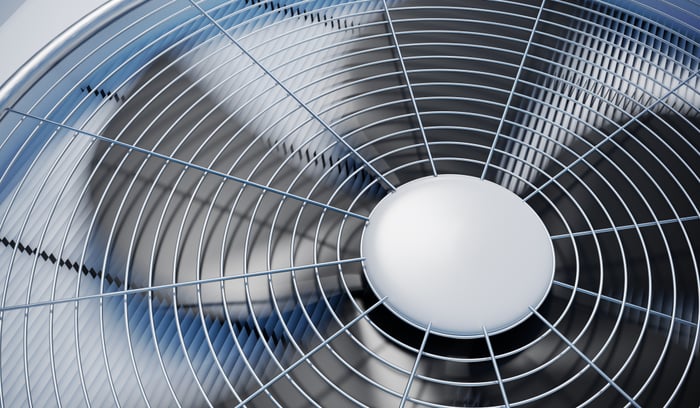How Air Quality Standards Can Improve Building Efficiency

Indoor air quality is fundamental for occupant health, and it also contributes to productivity in business environments. Many serious health conditions have been linked with long-term exposure to air pollutants, and there are also substances that cause immediate irritation of the respiratory system.
There is a common misconception that indoor air quality is at odds with energy efficiency. Although mechanical ventilation requires electricity, there are ways to enhance air quality without excessive fan power. Ideally, a building should get enough outdoor air to keep air pollutant concentrations low, but without wasting energy.
Get a ventilation design that offers energy efficiency and air quality.
ASHRAE offers two design procedures for mechanical ventilation. The Ventilation Rate Procedure (VRP) uses prescriptive airflow values that are based on research, while the Indoor Air Quality Procedure (IAQP) is based on controlling air pollutants directly. Unfortunately, many building codes only accept the VRP, since there is no standardized reference for air pollution levels under the IAQP.
- With the VRP, typical air pollutants found in each building type are factored into the prescriptive ventilation rates.
- On the other hand, the IAQP requires an air pollutant assessment during the design stage, and the ventilation system is sized accordingly.
If a ventilation system is designed directly for air pollution control, without prescriptive airflow values, there are two very important requirements. All relevant pollutants must be identified clearly, and the ventilation system must keep their concentrations below threshold values from trusted references, such as the World Health Organization.
How Air Pollution Thresholds Can Enhance Ventilation Design
Prescriptive airflow rates are easy to understand and their calculation procedure is straightforward. HVAC engineers must only know the floor area and number of occupants, and then multiply the corresponding outdoor air rates in cfm/sq.ft and cfm/person. However, a ventilation rate below the prescriptive value can be suitable when air pollution levels are very low.
A ventilation system that responds to pollutant concentrations can be more efficient than one responding to occupancy. Although there is correlation between the number of persons and air pollution, there are exceptions:
- Cleaning products release large amounts of volatile organic compounds, which means that air pollution can be high when only a few persons are cleaning indoor spaces.
- Some buildings such as convention centers are used for different activities, and this can change ventilation needs. For example, 2000 persons sitting at a large conference require less ventilation than 2000 persons in a fitness or dance event.
Prescriptive ventilation rates provide an established and tested procedure. However, a ventilation design based on pollutant levels has and additional feature: responding to changes in air pollution even when occupancy does not change. An air pollution standard with thresholds for all relevant substances would simplify the ventilation design process with the indoor air quality procedure. In great part, building codes limit this approach because there is no reference standard.
How Reduced Ventilation Achieves HVAC Savings

Ventilation systems have a much lower energy consumption than space heating and air conditioning equipment. However, since the ventilation system determines the outdoor air volume that must be heated or cooled, it has an impact on the total HVAC load. For example, if the outdoor airflow is reduced by 50% on a cold winter day, the required heating input for outdoor air is also reduced by half. The same applies for air conditioning during summer, where reduced airflow equals less cooling.
Demand controlled ventilation systems respond to occupancy, which is often monitored with carbon dioxide sensors. A ventilation control that responds to other air pollutants could follow the same approach, and the only difference is that more variables are considered. For example, volatile organic compounds and particulate matter can also be monitored for ventilation control.
To maximize the efficiency of a smart ventilation system, it can be equipped with variable frequency drives and NEMA Premium efficiency motors. This combination minimizes the electricity consumption per each cfm or air delivered. In the case of fractional horsepower applications, brushless DC motors offer high efficiency with built-in speed control. These are also known as electronically commutated motors.
Final Design Recommendations
An oversized ventilation system may seem like a quick solution to improve indoor air quality, but this approach is both expensive and inefficient. A larger ventilation system comes with a higher upfront cost, and more horsepower requires more electricity. A ventilation system of optimal capacity with speed controls provides is a much better solution, avoiding unnecessary expenses.
Designing a ventilation system for air pollution controls is a promising concept, but note that many building codes still specify minimum airflow rates according to tables. However, air pollution monitoring is useful even with this limitation - the ventilation system can respond to variations in air pollution levels even when occupancy has not changed. Ventilation efficiency could be improved by integrating and air pollution standard into building codes. There would be no need to provide a minimum outdoor airflow, as long as pollutant levels are kept under control.

Anuj Srivastava
Anuj Srivastava is a principal partner at NY Engineers. He is known for his MEP franchise market knowledge. Anuj is currently leading a team of 100+ MEP/FP engineers and has successfully led over 1500 franchise projects in the US.
Join 15,000+ Fellow Architects and Contractors
Get expert engineering tips straight to your inbox. Subscribe to the NY Engineers Blog below.

